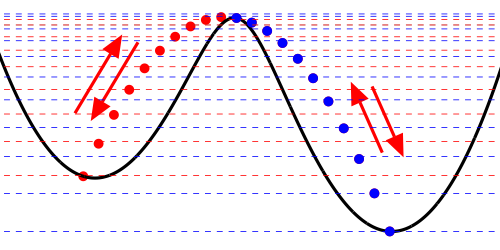Zap with Microwaves to Reverse Spin
To make higher-density magnetic data systems, researchers are looking to crystalline materials that have switchable magnetic orientations. But for some of these materials, switching the magnetization direction—for example from spin-up to spin-down—requires overcoming a large energy barrier. Now Seiji Miyashita at the University of Tokyo and Bernard Barbara of the Institut Néel, CNRS Grenoble, France, predict that experimentalists could reverse a material’s magnetization by applying to it a specific sequence of microwave or optical-frequency pulses [1]. The approach could find applications in quantum information storage.
To reverse the spin of a magnetic material, researchers can apply high temperatures or high magnetic fields to push the system over the potential energy barrier that separates its spin states. Another option is to induce resonant quantum tunneling to move electrons through the barrier. Miyashita and Barbara propose a further method that bypasses the constraints associated with the application of intense magnetic fields in these previous methods.
Miyashita and Barbara consider a magnetic crystalline system in which the pointing directions of the spins are uniaxially aligned. They then calculate what happens if they hit the system with a series of electromagnetic pulses. They show that such pulses can induce oscillations in the orientations of the spins where the amplitude of the oscillations extend above the potential energy barrier. For a carefully designed pulse sequence, the duo predicts that the oscillations can be fast enough—have a high enough energy—that with each back and forth they fully flip the spins’ directions.
The researchers think that their approach could be used to manipulate multiple qubits made of single-molecule magnets or rare-earth-element-based crystals. They also think that the method could provide an alternative strategy for integrating quantum magnetic systems into computing architectures.
–Rachel Berkowitz
Rachel Berkowitz is a Corresponding Editor for Physics Magazine based in Vancouver, Canada.
References
- S. Miyashita and B. Barbara, “How to cross an energy barrier at zero kelvin without tunneling effect,” Phys. Rev. Lett. 131, 066701 (2023).




